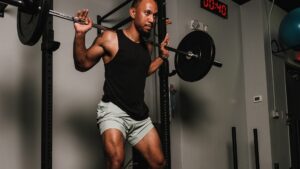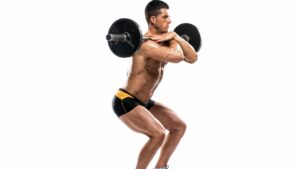Enhance Your Cycling Performance with These Essential Squats
1. Back Squats
Back squats are a powerhouse for building overall lower body strength. This compound movement engages your quadriceps, hamstrings, glutes, and lower back muscles essential for generating power during cycling. The upward movement mimics the action of pedaling, making it a great exercise to strengthen the muscles used in cycling.

How-to:
Stand with feet shoulder-width apart, a barbell resting across your upper back.
Lower yourself by bending your knees and hips, keeping your back straight.
Push through your heels to return to the starting position.
2. Front Squats
Front squats place more emphasis on the quadriceps and core, promoting better posture and stability on the bike. Strengthening these muscles aids in maintaining an upright position while riding, reducing fatigue and improving efficiency.

How-to:
Rest the barbell across your front shoulders, keeping your elbows high.
Lower into a squat by bending your knees and hips, keeping your chest up.
Push through your heels to rise back up.
3. Single-Leg Squats (Pistol Squats)
Single-leg squats are fantastic for addressing muscle imbalances and enhancing stability a critical factor in cycling performance. They target the glutes, hamstrings, and core while improving balance and coordination.

How-to:
Stand on one leg with the other leg extended in front.
Lower yourself down by bending the knee of the supporting leg.
Push back up to the starting position.
Incorporating these squats into your training routine, along with proper form and gradually increasing resistance, can yield substantial improvements in your cycling performance. Remember, consistency and progression are key to reaping the full benefits of these exercises.
Additional Tips for Maximizing Benefits:
Proper Form: Focus on maintaining proper form throughout each squat to prevent injury and maximize gains.
Progressive Overload: Gradually increase the weight or difficulty to continually challenge your muscles and promote growth.
Recovery: Allow adequate rest and recovery between squat sessions to avoid overtraining and support muscle repair.
So.
Incorporating these squat variations into your training routine can significantly enhance your cycling performance by strengthening key muscle groups, improving stability, and boosting overall power. Remember, consistency and proper technique are fundamental for reaping the full benefits of these exercises.
The Science Behind Squats and Cycling Performance
Understanding the physiological impact of squats on cycling performance can shed light on why these exercises are so effective in enhancing your riding abilities.
Muscle Engagement
Squats engage major muscle groups crucial for cycling—quadriceps, hamstrings, glutes, and core. The concentric and eccentric movements during squats mimic the leg action in pedaling, promoting muscle development in the exact areas needed for generating power on the bike.
Strength and Power
Building strength through squats directly translates to increased power output on the bike. Stronger leg muscles allow for more forceful pedaling, enabling cyclists to conquer inclines and sprints more efficiently.
Stability and Balance
Front and single-leg squats specifically target stabilizing muscles. Improved stability not only prevents injuries but also enhances balance on the bike, especially when navigating uneven terrain or making sharp turns.
Injury Prevention
Squats contribute to better joint stability and flexibility, reducing the risk of common cycling injuries. Strengthening muscles around the knees, hips, and lower back can mitigate the impact of long rides and repetitive motion, minimizing the likelihood of overuse injuries.
Performance Endurance
Endurance is key in cycling, and squats play a role here too. They enhance muscular endurance, allowing cyclists to maintain power output for longer durations, ultimately delaying the onset of fatigue during rides.
Recovery and Regeneration
Properly executed squats stimulate blood flow to muscles, aiding in quicker recovery post-ride. This facilitates muscle repair and growth, preparing cyclists for subsequent training sessions or competitions.
Elevate Your Cycling with Squats
Incorporating squats into your training routine can be a game-changer, but it’s essential to approach them strategically:
Diversify Your Squats: Experiment with different types of squats to target various muscle groups and prevent plateaus.
Consistency Matters: Regularly integrating squats into your regimen ensures continuous improvement in strength and performance.
Listen to Your Body: Pay attention to any discomfort or pain during squats. Proper form is crucial to prevent injuries.
Balance and Complement: Combine squats with other strength-training exercises and cycling-specific workouts for a well-rounded training plan.
By understanding the benefits of squats and their impact on cycling performance, cyclists can tailor their training routines to achieve optimal results on the road or trail.
External Resources:
Further explore the science behind squats and their impact on cycling performance with these resources:
- Science of Cycling – How Strength Training Improves Cycling Performance
- Breaking Muscle – Squats for Cyclists: Strength, Power, and Injury Prevention
- Cyclingnews – Strength Training for Cyclists: A Beginner’s Guide
By leveraging the science-backed benefits of squats, cyclists can optimize their training to achieve peak performance, endurance, and resilience, ultimately elevating their cycling experience. Ride strong, ride safe!
External Resources:
To delve deeper into optimizing your cycling performance through squats, explore these resources:
Comparison tabular
Here’s a comparison table highlighting the key aspects of the three main types of squats beneficial for cyclists:
| Squat Type | Focus Muscles | Benefits | How-to |
|---|---|---|---|
| Back Squats | Quadriceps, Hamstrings, | – Overall lower body strength
– Mimics pedaling motion – Builds power for cycling |
1. Stand with feet shoulder-width apart
2. Barbell across upper back 3. Lower, keep back straight, rise up |
| Glutes, Lower Back | |||
| Front Squats | Quadriceps, Core | – Emphasizes core stability
– Aids in posture maintenance – Enhances balance on the bike |
1. Barbell in front shoulders, elbows high
2. Lower, chest up, rise up |
| **Single-Leg | Glutes, Hamstrings, Core | – Targets imbalances
– Improves stability and coordination – Strengthens specific cycling-related muscles |
1. Stand on one leg, other leg extended
2. Lower on supporting leg, rise up |
| Squats** |
Which Squat is Best for You?
Back Squats are ideal for overall lower body strength, replicating the pedaling motion.
Front Squats emphasize core stability, aiding posture maintenance and balance on the bike.
Single-Leg Squats target imbalances, improve stability, and strengthen cycling-specific muscles.
Choosing the right squat for your routine depends on your specific goals and areas you aim to strengthen for improved cycling performance. Incorporating a mix of these squats can offer a well-rounded approach to enhancing your cycling abilities.
Wrapping up
In the pursuit of mastering cycling performance, integrating squats into your training regimen stands as a powerful strategy. These exercises not only fortify your muscles but also enhance stability, balance, and endurance key elements essential for excelling on the bike.
Remember, the journey to peak cycling performance isn’t solely about pushing pedals; it’s about cultivating strength, resilience, and efficiency in every pedal stroke. By embracing squats be it back squats for raw power, front squats for core stability, or single-leg squats for balance you equip yourself with a holistic approach to elevate your cycling prowess.
Consistency, proper form, and a well-rounded training plan incorporating diverse squat variations will pave the way for sustained improvements in your cycling journey. So, strap on your cycling shoes, hit the road, and feel the power of squats propelling you towards your cycling aspirations.
Ride strong, ride smart, and enjoy the exhilarating journey ahead!

Hey there, it’s Mike Rrsq, the Editor-in-Chief over at Jsquat.com, and I’m absolutely obsessed with all things squat fitness! I’ve been lucky enough to get some serious recognition for my work in this field. With a solid background in the fitness and wellness industry, I’ve been there right from the get-go, helping shape this website into what it is today.
You see, I’m not just the boss around here; I’m also a passionate contributor. I love sharing my insights through my articles, and trust me, they’re not your run-of-the-mill stuff. Each piece I write is a labor of love, filled with my expertise and real-world experience in the fitness universe. So, if you’re into fitness and looking for some inspiration, you’re in the right place!
Related Posts
- The Top 3 Effective Squat Variations for Improved Weightlifting Performance in 28-year-old male
Weightlifting demands a robust foundation, and the right squat variation can be a game-changer for…
- Best 3 most effective squat variations you need for targeting the adductor magnus.
Squat is one of the most effective exercises that you can do to target quads…
- The Best 3 Most Effective Squat variations for targeting the obliques.
Squats are renowned for their ability to strengthen and tone the lower body, but did…
- The top 4 effective squat Variations 20-year-old females need for better Olympic lifting performance
For a 20-year-old female aiming to enhance Olympic lifting performance, incorporating specific squat variations can…
- The top 3 effective squat Variations 19-year-old males need to build explosive strength
Squats are foundational exercises for enhancing lower body strength and power. For a 19-year-old male…
- The top 3 effective squat Variations 23-year-old males need for better powerlifting performance
Powerlifting is a thrilling sport that demands strength, technique, and dedication. Among the foundational exercises,…
- Best 3 Most Effective Squat Variations you need for targeting the transverse abdominis.
When it comes to strengthening the core, especially the often elusive transverse abdominis, selecting the…
- The 3 most effective squat variations you need to do for targeting the biceps femoris.
When it comes to strengthening and targeting the biceps femoris, a key muscle in the…
